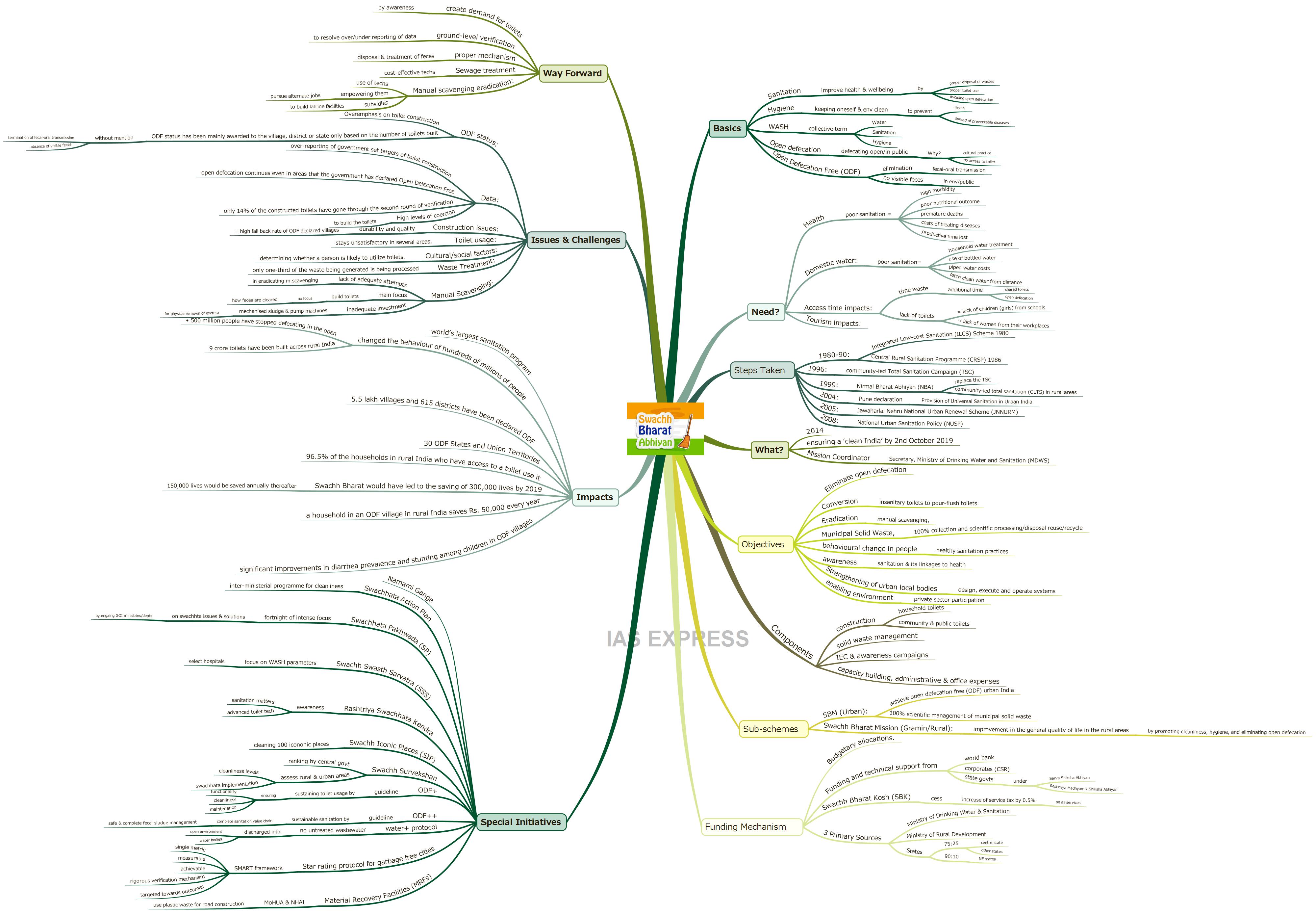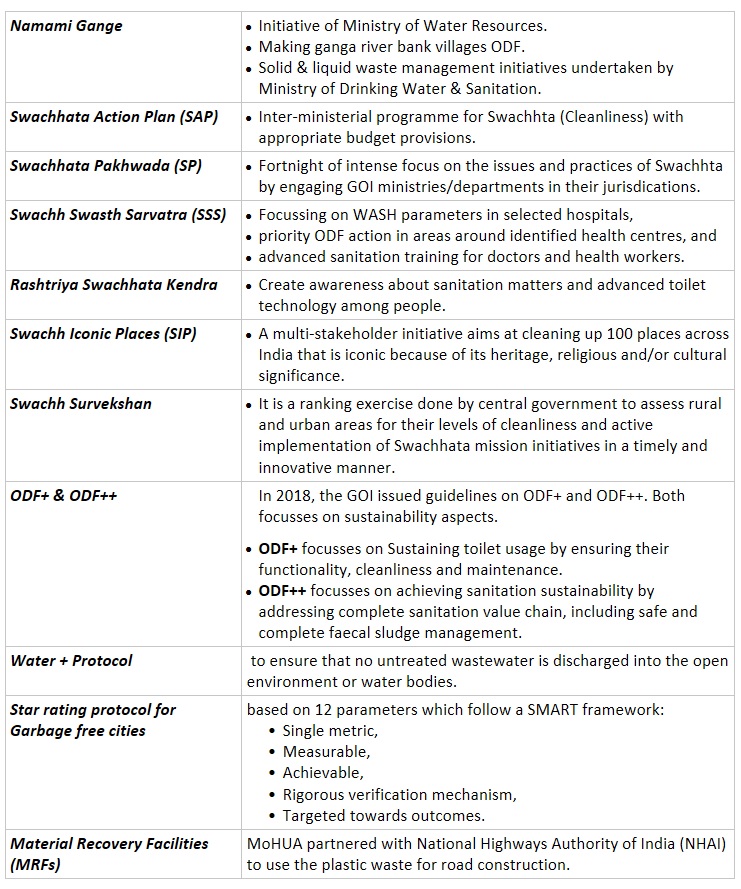Swachh Bharat Mission – Is it a Success or a Failure?

Updates*
Poor sanitation is a primary cause of diseases worldwide = improving sanitation can have a beneficial impact on health both in households as well as communities. In order to meet the sanitation need, the government had launched the Swachh Bharat Mission in 2014. Since then, SBM became the world’s largest sanitation program by changing the behaviour of hundreds of millions of people with respect to toilet access and usage. However, there are also concerns regarding the overreporting of data, actual usage of toilets, etc. which we will discuss in this article.
This topic of “Swachh Bharat Mission – Is it a Success or a Failure?” is important from the perspective of the UPSC IAS Examination, which falls under General Studies Portion.
Basics:
- Sanitation refers to measures needed for improving and protecting health and wellbeing of the people by promoting proper disposal of human and animal wastes, proper use of toilet and avoiding open defecation.
- Hygiene refers to the practice of keeping oneself and the environment clean particularly to prevent illness or spread of preventable diseases.
- WASH: WASH is the collective term for Water, Sanitation, and Hygiene. Due to their interdependent nature, these three core issues are grouped together to represent a growing sector. While each a separate field of work, each is dependent on the presence of the other. For example, without toilets, water sources become contaminated; without clean water, basic hygiene practices are not possible. WASH is the focus of sustainable development goal 6.
- Open Defecation: is the practice of defecating outside or in public. This may be done due to cultural practices or having no access to the toilet.
- Open Defecation Free (ODF): Elimination of fecal-oral transmission, that is, no visible feces found in the environment, village, every household as well as public/community institutions using safe technology options for disposal of feces.
What are the effects of poor sanitation?/What was the need for Swachh Bharat?
- Health-related impacts: High morbidity, poor nutritional outcome, premature deaths, costs of treating diseases, productive time lost because of people falling ill, and time lost by caregivers who look after them.
- Domestic water-related impacts: Household treatment of water, use of bottled water, costs of obtaining piped water, and time costs of fetching clean water from a distance.
- Access time impacts: Cost of additional time spent for accessing shared toilets or open defecation sites, absence of children (particularly girls) from school and women from their workplaces due to lack of provision of toilets.
- Tourism impacts: Potential loss of tourism revenues and economic impacts due to gastrointestinal diseases among foreign tourists caused by poor sanitation in India.
What are the steps taken earlier to promote sanitation in India? (Historical overview)
1980-90:
- Integrated Low-cost Sanitation (ILCS) Scheme 1980.
- Central Rural Sanitation Programme (CRSP) 1986 – during the International Water and Sanitation Decade (1980-90).
1996:
- CRSP was restructured and a community-led Total Sanitation Campaign (TSC) was introduced.
1999:
- The Nirmal Bharat Abhiyan (NBA) was launched to replace the TSC. The focus here was on the principles of community-led total sanitation (CLTS) in rural areas.
2004: Urban Sanitation started receiving focus following the Pune declaration titled “Provision of Universal Sanitation in Urban India”.
2005: Jawaharlal Nehru National Urban Renewal Scheme (JNNURM) was launched.
2008: National Urban Sanitation Policy (NUSP) was launched.
What is the Swachh Bharat Mission (SBM)?
- Swachh Bharat Mission (SBM) was launched in 2014 with the aim of ensuring a ‘clean India’ by 2nd October 2019 as a fitting tribute to Mahatma Gandhi on his 150th Birth Anniversary.
- The Mission Coordinator for SBM is Secretary, Ministry of Drinking Water and Sanitation (MDWS).
What are the objectives of the Swachh Bharat Mission?
- Eliminate open defecation.
- Conversion of insanitary toilets to pour-flush toilets,
- Eradication of manual scavenging,
- 100% collection and scientific processing/disposal reuse/recycle of Municipal Solid Waste,
- To bring about a behavioural change in people with regards to healthy sanitation practices,
- Create awareness among the citizens about sanitation and its linkages with public health.
- Strengthening of urban local bodies to design, execute and operate systems,
- To create an enabling environment for private sector participation in Capital Expenditure and Operation & Maintenance (O&M) costs.
What are the components of the Swachh Bharat Mission?
- Construction of household toilets.
- Community & public toilets.
- Solid waste management.
- Information, Education & Communication (IEC) and Public Awareness.
- Capacity building and administrative & office expenses (A&OE).
What are the sub-schemes of Swachh Bharat?
- Swachh Bharat Mission (Urban): It seeks to achieve open defecation free (ODF) urban India and 100% scientific management of municipal solid waste in 4041 statutory towns in the country.
- Swachh Bharat Mission (Gramin/Rural): It seeks to bring about an improvement in the general quality of life in the rural areas, by promoting cleanliness, hygiene, and eliminating open defecation.
What is the funding mechanism of Swachh Bharat?
- Budgetary allocations.
- Funding and technical support from the World Bank, corporations as part of corporate social responsibility (CSR) initiatives, and by state governments under the ‘Sarva Shiksha Abhiyan’ and ‘Rashtriya Madhyamik Shiksha Abhiyan’
- Swachh Bharat Kosh(SBK): Swachh Bharat cess is an improvement in the service tax by 0.5% on all the services in India.
- The funding for 9 crore toilets is expected to come from 3 primary sources – Ministry of Drinking Water & Sanitation, Ministry of Rural Development, and the States in the ratio of 75:25 between centre and State and 90:10 for North Eastern state.
What are the special initiatives and projects under the Swachh Bharat Mission? *
What is the impact of Swachh Bharat?
Since its launch in October 2014, the SBM, the world’s largest sanitation program, has changed the behaviour of hundreds of millions of people with respect to toilet access and usage.
- 500 million people have stopped defecating in the open since the SBM began, down from 550 million at the beginning of the programme to less than 50 million today.
- Over 9 crore toilets have been built across rural India under the Mission. Over 5.5 lakh villages and 615 districts have been declared ODF, along with 30 ODF States and Union Territories.
The National Annual Rural Sanitation Survey (NARSS) 2018-19, conducted by an Independent Verification Agency (IVA) under the World Bank support project to the Swachh Bharat Mission Grameen (SBM-G), has found that 96.5% of the households in rural India who have access to a toilet use it.
- The NARSS confirmed the Open Defecation Free (ODF) status of 90.7% of villages which were previously declared and verified as ODF by various districts/States.
- 1% of households were found to have access to toilets during the survey period (the corresponding figure as per the SBMG MIS in November 2018 was 96%)
- 5% of the people who had access to toilets used them.
- 7% of villages which were previously declared and verified as ODF were confirmed to be ODF. The remaining villages also had sanitation coverage of about 93%.
- 4% of the villages surveyed found to have a minimal litter and minimal stagnant water.
A recent WHO study reports that Swachh Bharat would have led to the saving of 300,000 lives by 2019 and around 150,000 lives would be saved annually thereafter.
In a report titled ‘The Financial and Economic Impact of SBM in India (2017)’ UNICEF estimated that a household in an ODF village in rural India saves Rs. 50,000 every year.
Bill & Melinda Gates Foundation (BMGF) has released a study that shows significant improvements in diarrhea prevalence and stunting among children in ODF villages, compared to nearby non-ODF villages.
What are the issues and challenges?
ODF status:
- Overemphasis on toilet construction rather than focussing on all parameters.
- The ODF status has been mainly awarded to the village, district or state only based on the number of toilets built without mention of termination of fecal-oral transmission and absence of visible feces in the environment as major parameters in the SBM guidelines.
- The ODF status has been questioned by the Comptroller and Auditor General (CAG) of India in September 2018 report.
Data: It has also been alleged that there is over-reporting of government set targets of toilet construction.
- independent surveys show open defecation continues even in areas that the government has declared Open Defecation Free
- The government’s own data shows only 14% of the constructed toilets have gone through the second round of verification
- High levels of coercion have been used to build the toilets and behavioural change has been slow to follow.
Construction issues: There are concerns regarding the durability and quality of construction of toilets. It is observed that fall back rate of ODF declared villages in the past was high because of the non-sustainability of toilets.
Toilet usage: SBM has been primarily a supply-side measure aims at construction of toilets. Though there has been considerable toilet construction, the toilet usage stays unsatisfactory in several areas. The National Family Health Survey (NFHS-4), 2016-17 found that open defecation remained fairly high in the rural areas of the BIMAROU states – Bihar, Madhya Pradesh, Rajasthan, Orissa, and Uttar Pradesh.
Cultural/social factors: Religion and caste play a crucial role in determining whether a person is likely to utilize toilets. Open defecation stays a common practice in several rural areas because of cultural and societal factors that shape the behaviour towards sanitation.
Waste Treatment: Despite considerable progress in the door to door waste collection, only one-third of the waste being generated is being processed.
- SBM has made inadequate attempts at critical areas of eradication of manual scavenging and rehabilitation of such workers.
- SBM is primarily focussed on constructing toilets without any strategy about how they are to be cleared.
- There has been an insufficient investment on procuring mechanized sludge and pump machines for physical removal of excreta.
- Moreover, the campaign does not address a reworking of the underground sewerage system.
What needs to be done?
- Creating demand: The government should focus on creating a demand for toilets. Policymakers must make sure that a higher proportion of funds are directed towards educating people about hygiene and the social marketing of toilets.
- Ground-level verification: To resolve the issue of over/under reporting of government set targets, verification of facts on the ground is highly important.
- Disposal of feces: proper facilities for the disposal of excreta should be established. People started using toilets but the fecal material goes untreated which harms the environment.
- Sewage Treatment: Different cost-effective technologies must be adopted for sewage treatments and proper disposal of waste from toilets.
- Manual scavenging: Use of technology can play a crucial role in eradicating the practice of manual scavenging. Empowering the lower castes by encouraging them to pursue alternative jobs and possibly providing them with subsidies to build latrine facilities can also be a step in this direction.
Practice questions:
- ‘Swachh Bharat has become a people’s movement’. Examine the given statement in the context of the outcome of the Swachh Bharat Mission so far. Also, discuss the impact of SBM on the lives of the ordinary citizen.
- The success of Swachh Bharat mission lies in the behavioral change it has managed to bring, more than anything else. Critically analyze.



